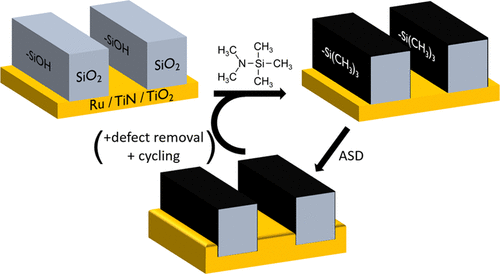当前位置:
X-MOL 学术
›
J. Phys. Chem. C
›
论文详情
Our official English website, www.x-mol.net, welcomes your
feedback! (Note: you will need to create a separate account there.)
Insight into Selective Surface Reactions of Dimethylamino-trimethylsilane for Area-Selective Deposition of Metal, Nitride, and Oxide
The Journal of Physical Chemistry C ( IF 3.3 ) Pub Date : 2020-03-24 , DOI: 10.1021/acs.jpcc.9b11270 Job Soethoudt 1, 2 , Yoann Tomczak 2 , Ben Meynaerts 1, 2 , Boon Teik Chan 2 , Annelies Delabie 1, 2
The Journal of Physical Chemistry C ( IF 3.3 ) Pub Date : 2020-03-24 , DOI: 10.1021/acs.jpcc.9b11270 Job Soethoudt 1, 2 , Yoann Tomczak 2 , Ben Meynaerts 1, 2 , Boon Teik Chan 2 , Annelies Delabie 1, 2
Affiliation

|
Area-selective deposition (ASD) is a promising bottom-up manufacturing solution for catalysts and nanoelectronic devices. However, industrial applications are limited as highly selective ASD processes exist only for few materials. “Passivation/deposition/defect removal” cycles have been proposed to increase selectivity, but cycling requires the passivation to be selective to the growth surface as well as the ASD-grown material. Dimethylamino-trimethylsilane (DMA-TMS) can passivate SiO2 surfaces by covering them with −Si(CH3)3 groups. However, the interaction of DMA-TMS with materials other than SiO2 and Si remains largely unknown and its compatibility with cycling is not yet understood. This work investigates the selectivity of metal, nitride, and oxide atomic layer deposition (ALD) to DMA-TMS-passivated SiO2 as well as the surface chemistry and selectivity of the DMA-TMS reaction. The ALD coreagents O2, NH3, and H2O show low reactivity with the −Si(CH3)3-terminated surface at temperatures up to 300 °C, but the selectivity of ALD strongly depends on the metal precursor and temperature. We demonstrate that DMA-TMS is a selective passivation agent for ASD of and on TiO2, TiN, and Ru selective to SiO2, by TiCl4/H2O, TiCl4/NH3, and EBECHRu/O2 ALD, respectively. We investigate the DMA-TMS reaction on Ru and TiN/TiO2 growth surfaces under conditions that passivate SiO2. At least 77% of the area of the growth surface remains reactive for ALD, confirming the compatibility of DMA-TMS with cycling for ASD. We investigate the impact of changes in surface composition due to patterning before ASD and find that DMA-TMS removes F impurities on TiN and TiO2 surfaces. DMA-TMS selectively passivates SiO2 on three-dimensional (3D) nanopatterns, allowing preferential TiO2 deposition on a nonpassivated growth surface. Thus, the selectivity of DMA-TMS shows great promise to expand the ASD material space as well as to increase selectivity during ASD cycles.
中文翻译:

洞察二甲基氨基三甲基硅烷对金属,氮化物和氧化物进行区域选择性沉积的选择性表面反应
区域选择性沉积(ASD)是一种有前途的自底向上制造解决方案,用于催化剂和纳米电子器件。但是,工业应用受到限制,因为仅对几种材料存在高度选择性的ASD工艺。已经提出了“钝化/沉积/缺陷去除”循环来提高选择性,但是循环要求钝化对生长表面以及ASD生长的材料具有选择性。二甲基氨基三甲基硅烷(DMA-TMS)可以通过用-Si(CH 3)3基团覆盖来钝化SiO 2表面。但是,DMA-TMS与SiO 2以外的材料的相互作用Si在很大程度上仍然未知,并且其与循环的兼容性尚不明确。这项工作研究了金属,氮化物和氧化物原子层沉积(ALD)对DMA-TMS钝化的SiO 2的选择性,以及DMA-TMS反应的表面化学性质和选择性。ALD核心试剂O 2,NH 3和H 2 O在高达300°C的温度下与-Si(CH 3)3终止的表面表现出低反应性,但是ALD的选择性很大程度上取决于金属前体和温度。我们证明,DMA-TMS是一种选择性的钝化剂的TiO和ASD 2,TiN和钌选择性为SiO 2,通过的TiCl 4/ H 2 O,TiCl 4 / NH 3和EBECHRu / O 2 ALD。我们研究了在钝化SiO 2的条件下Ru和TiN / TiO 2生长表面上的DMA-TMS反应。生长表面的至少77%的区域仍对ALD具有反应性,从而证实了DMA-TMS与ASD循环的相容性。我们调查了由于ASD之前的图案形成而引起的表面成分变化的影响,发现DMA-TMS去除了TiN和TiO 2表面上的F杂质。DMA-TMS在三维(3D)纳米图案上选择性钝化SiO 2,允许优先使用TiO 2沉积在非钝化生长表面上。因此,DMA-TMS的选择性显示出扩大ASD材料空间以及增加ASD循环选择性的巨大希望。
更新日期:2020-03-26
中文翻译:

洞察二甲基氨基三甲基硅烷对金属,氮化物和氧化物进行区域选择性沉积的选择性表面反应
区域选择性沉积(ASD)是一种有前途的自底向上制造解决方案,用于催化剂和纳米电子器件。但是,工业应用受到限制,因为仅对几种材料存在高度选择性的ASD工艺。已经提出了“钝化/沉积/缺陷去除”循环来提高选择性,但是循环要求钝化对生长表面以及ASD生长的材料具有选择性。二甲基氨基三甲基硅烷(DMA-TMS)可以通过用-Si(CH 3)3基团覆盖来钝化SiO 2表面。但是,DMA-TMS与SiO 2以外的材料的相互作用Si在很大程度上仍然未知,并且其与循环的兼容性尚不明确。这项工作研究了金属,氮化物和氧化物原子层沉积(ALD)对DMA-TMS钝化的SiO 2的选择性,以及DMA-TMS反应的表面化学性质和选择性。ALD核心试剂O 2,NH 3和H 2 O在高达300°C的温度下与-Si(CH 3)3终止的表面表现出低反应性,但是ALD的选择性很大程度上取决于金属前体和温度。我们证明,DMA-TMS是一种选择性的钝化剂的TiO和ASD 2,TiN和钌选择性为SiO 2,通过的TiCl 4/ H 2 O,TiCl 4 / NH 3和EBECHRu / O 2 ALD。我们研究了在钝化SiO 2的条件下Ru和TiN / TiO 2生长表面上的DMA-TMS反应。生长表面的至少77%的区域仍对ALD具有反应性,从而证实了DMA-TMS与ASD循环的相容性。我们调查了由于ASD之前的图案形成而引起的表面成分变化的影响,发现DMA-TMS去除了TiN和TiO 2表面上的F杂质。DMA-TMS在三维(3D)纳米图案上选择性钝化SiO 2,允许优先使用TiO 2沉积在非钝化生长表面上。因此,DMA-TMS的选择性显示出扩大ASD材料空间以及增加ASD循环选择性的巨大希望。











































 京公网安备 11010802027423号
京公网安备 11010802027423号